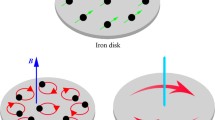Abstract
Using the path integral approach to equilibrium statistical physics the effect of dissipation on Landau diamagnetism is calculated. The calculation clarifies the essential role of the boundary of the container in which the electrons move. Further, the derived result for diamagnetization also matches with the expression obtained from a time-dependent quantum Langevin equation in the asymptotic limit, provided a certain order is maintained in taking limits. This identification then unifies equilibrium and nonequilibrium statistical physics for a phenomenon like diamagnetism, which is inherently quantum and strongly dependent on boundary effects. In addition we have shown that our results are directly connected with fluctuation induced diamagnetic susceptibility of superconducting grains.
Similar content being viewed by others
References
N. Bohr, Dissertation, Copenhegen, 1911; J. H. Van Leeuwen. J. Phys. (Paris) 2:361 (1921).
L. Landau, Z. Phys. 64:629 (1930).
J. H. Van Vleck, The Theory of Electric and Magnetic Susceptibilities (Oxford University Press, London, 1932).
R. Peierls, Surprises in Theoretical Physics (Princeton University Press, Princeton, 1979).
S. Datta, Electronic Transport in Mesoscopic Systems (Cambridge University Press, 1995).
S. Dattagupta and J. Singh, Phys. Rev. Lett. 79:961 (1997); henceforth referred to as I.
N. Ashcroft and D. Mermin; Solid State Physics (Holt, Rinehart and Winston, New York, 1976).
X. L. Li, G. W. Ford, and R. F. O'Connell, Phys. Rev. E 53:3359 (1996); G. W. Ford, M. Kac, and P. Mazur, J. Math. Phys. (N. Y.) 6:504 (1965); G. W. Ford, J. T. Lewis, and R. F. O'Connell, Phys. Rev. A 37:4419 (1988).
A. O. Caldeira and A. J. Leggett, Ann. Phys. (N.Y.) 149:374 (1983).
L. P. Kadanoff, Statistical Physics—Statics, Dynamics and Renormalization (World Scientific, Singapore, 2000).
W. Zwerger, J. Low Temp. Phys. 72:291 (1988).
M. Tinkham, Introduction To Superconductivity (McGraw-Hill, Singapore, 1996).
D. Dalidovich and P. Philipps, Phys. Rev. Lett. 84:737 (2000).
Y. Imry, Introduction to Mesoscopic Physics (Oxford University Press, 1977).
R. P. Feynman and F. L. Vernon, Ann. Phys. (N.Y.) 24:118 (1963).
C. G. Darwin, Proc. Cambridge Philos. Soc. 27:86 (1930).
A.O. Caldeira and A. J. Leggett, Phys. Rev. Lett. 46:211 (1981).
L. D. Chang and S. Chakravarty, Phys. Rev. B 31:154 (1985).
R. P. Feynman, Rev. Mod. Phys. 20:367 (1948).
R. P. Feynman and A. R. Hibbs, Quantum Mechanics and Path Integrals (Mcgraw-Hill, 1965).
H. Kleinert, Path Integrals in Quantum Mechanics, Statistics, Polymer Physics and Financial Markets (World Scientific, 2004).
U. Weiss, Quantum Dissipative Systems (World Scientific, 1999).
T. Dittrich, P. Hänggi, G.-L. Ingold, B. Kramer, G. Schön and W. Zwerger, Quantum Transport and Dissipation (WILEY-VCH Verlag GmbH, 1998).
S. Dattagupta and S. Puri, Dissipative Effects in Condensed Matter Physics (Springer Verlag, Heidelberg, 2004).
G.S. Agarwal, Quantum Optics, vol. 70 of Springer—Tracts in Modern Physics, edited by G. Hohler (Springer Verlag, Berlin, 1974).
H. Grabert, P. Schramm, and G. Ingold, Phys. Rep. 168:115 (1988).
R. Balian, From Microphysics to Macrophysics: methods and applications of statistical physics, Vol 1 (Springer-Verlag, 1991)
R. Benguria and M. Kac, Phys. Rev. Lett. 46:1 (1981).
A. M. Jayannavar and N. Kumar, J. Phys. A 14:1399 (1981).
Author information
Authors and Affiliations
Corresponding author
Additional information
PACS Number: 03.65.Yz, 05.20.-y, 05.20.Gg, 05.40.-a, 75.20.-g
Rights and permissions
About this article
Cite this article
Bandyopadhyay, M., Dattagupta, S. Dissipative Diamagnetism—A Case Study for Equilibrium and Nonequilibrium Statistical Mechanics. J Stat Phys 123, 1273–1284 (2006). https://doi.org/10.1007/s10955-006-9114-y
Received:
Accepted:
Published:
Issue Date:
DOI: https://doi.org/10.1007/s10955-006-9114-y




